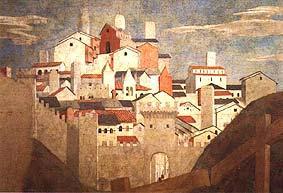


All the structures

Arezzo stands 296 m. above sea level on a hilly slope near a wide plateau on which open the Valdarno, Casentino and Valdichiana valleys. Of Etruscan origin, it was an important Roman Municipium in the Imperial period; after the fall of the Empire it came first under Goth then Byzantine, Lombard and Frankish rule. Between the 9th and 11th centuries it was governed by the Bishop-Counts before becoming a free municipality (late 11th century). This was the town's period of greatest splendour.
Old rivalry with Siena and Florence, marked also by defeat at Campaldino at the hand of the Florentines (1289), gradually sapped its power until, in 1384, it was definitively joined to the Florentine State, sharing its fortunes until unification with Italy.
The principal monuments are to be found in the old town centre, which has a Renaissance appearance: Pieve di S. Maria (12th century, Romanesque, with a beautiful façade, inside, a polyptych by P. Lorenzetti), Basilica of S. Francesco (14th century, housing the `Leggenda della Croce', a series of frescoes by Piero della Francesca), Palazzo della Fraternità dei Laici (Gothic-Renaissance, 14th century), church of S. Domenico (13th-14th century, crucifix by Cimabue), Duomo (13th-16th century), Casa del Vasari (16th century).
As regards the economy, Arezzo is still an important market for agricultural and animal products from the fertile surrounding districts. Industry is also of note, favoured by good road and rail communications (Florence-Rome line) and is present in the clothing, footwear and engineering sectors. Crafts (jewelry) and tourism are also quite important.
Famous People: Francesco Petrarca (poet, 1304-1374), Guittone d'Arezzo (poet, 1230-1294), Pietro Aretino (poet, 1492-1557), Leone Leoni (goldsmith, 1509-1590), Giorgio Vasari (painter and architect, 1511-1574), Guido d'Arezzo (inventor of the stave, 992-1050).
Cultural Institutions: Petrarca Academy of Science, Letters and Arts, Costanti Academy, Mecenate Archeological Museum, Vasarian Museum and Archives, Diocesan Museum of Religious Art, Medieval and Modern Museum and Gallery, Petrarca Theatre.
In the Province: Cortona (Etruscan Academy, Archeological Museum), Sansepolcro (environmental interest, pasta factories), S. Giovanni Valdarno (industry), Caprese Michelangelo (Michelangelo museum), Montevarchi (Paleontological Museum), Anghiari (Museum of peasant art and traditions in the upper Val Tiberina).